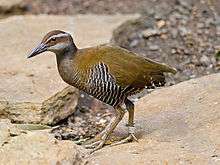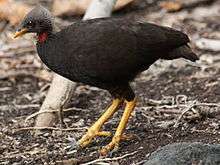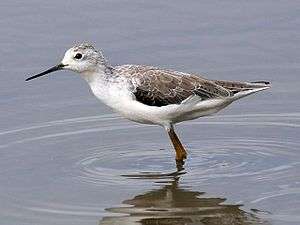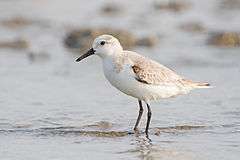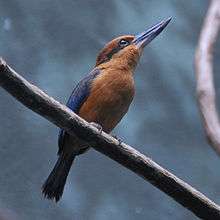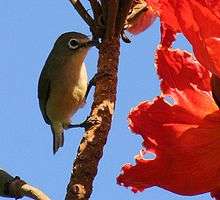List of birds of Guam
This is a list of the bird species recorded in Guam. The avifauna of Guam include a total of 124 species, of which three are endemic, nine have been introduced by humans and one is rare or accidental. Four species listed are extirpated in Guam and are not included in the species count. Six species are globally threatened.
This list's taxonomic treatment (designation and sequence of orders, families and species) and nomenclature (common and scientific names) follow the conventions of The Clements Checklist of Birds of the World, 5th edition. The family accounts at the beginning of each heading reflect this taxonomy, as do the species counts found in each family account. Introduced and accidental species are included in the total counts for Guam.
The following tags have been used to highlight several categories. Not all species fall into one of these categories. Those that do not are commonly occurring native species.
- (A) Accidental - a species that rarely or accidentally occurs in Guam
- (*) Endemic - a species either entirely confined to Guam in its natural distribution, or a species whose breeding range is entirely confined to Guam
- (E) Extinct - a recent bird that no longer exists
- (EW) Extinct in the wild - a species which only exists in captive breeding programs
- (I) Introduced - a species introduced to Guam as a consequence, direct or indirect, of human actions
- (Ex) Extirpated - a species that no longer occurs in Guam although populations exist elsewhere
| Table of contents |
|---|
|
Non-passerines: Shearwaters and petrels • Storm petrels • Tropicbirds • Boobies and gannets • Frigatebirds • Bitterns, herons and egrets • Ducks, geese and swans • Osprey • Hawks, kites and eagles • Caracaras and falcons • Megapodes • Pheasants and partridges • Rails, crakes, gallinules and coots • Oystercatchers • Stilts and avocets • Plovers and lapwings • Sandpipers and allies • Pratincoles • Gulls • Terns • Pigeons and doves • Typical owls • Swifts • Kingfishers |
|
Passerines: Swallows and martins • Wagtails and pipits • Acrocephalid warblers • Fantails • Monarch flycatchers • White-eyes • Honeyeaters • Drongos • Crows, jays, ravens and magpies • Starlings • Waxbills and allies • Sparrows |
Shearwaters and petrels
Order: Procellariiformes Family: Procellariidae
The procellariids are the main group of medium-sized "true petrels", characterized by united nostrils with medium septum and a long outer functional primary.
- Juan Fernandez petrel, Pterodroma externa
- Tahiti petrel, Pseudobulweria rostrata
- Streaked Shearwater, Calonectris leucomelas
- Wedge-tailed shearwater, Ardenna pacificus
- Short-tailed shearwater, Ardenna tenuirostris
- Newell's shearwater, Puffinus newelli (A)
- Tropical shearwater, Puffinus bailloni
Storm petrels
Order: Procellariiformes Family: Hydrobatidae
The storm petrels are relatives of the petrels and are the smallest seabirds. They feed on planktonic crustaceans and small fish picked from the surface, typically while hovering. The flight is fluttering and sometimes bat-like.
- Leach's storm petrel, Oceanodroma leucorhoa
- Matsudaira's storm petrel, Oceanodroma matsudairae
Tropicbirds
Order: Phaethontiformes Family: Phaethontidae
Tropicbirds are slender white birds of tropical oceans, with exceptionally long central tail feathers. Their heads and long wings have black markings.
- Red-tailed tropicbird, Phaethon rubricauda
- White-tailed tropicbird, Phaethon lepturus
Boobies and gannets
Order: Suliformes Family: Sulidae
The sulids comprise the gannets and boobies. Both groups are medium to large coastal seabirds that plunge-dive for fish.
- Masked booby, Sula dactylatra
- Red-footed booby, Sula sula
- Brown booby, Sula leucogaster
Frigatebirds
Order: Suliformes Family: Fregatidae
Frigatebirds are large seabirds usually found over tropical oceans. They are large, black and white or completely black, with long wings and deeply forked tails. The males have colored inflatable throat pouches. They do not swim or walk and cannot take off from a flat surface. Having the largest wingspan-to-body-weight ratio of any bird, they are essentially aerial, able to stay aloft for more than a week.
- Great frigatebird, Fregata minor
- Lesser frigatebird, Fregata ariel (A)
Bitterns, herons and egrets
Order: Pelecaniformes Family: Ardeidae
The family Ardeidae contains the bitterns, herons and egrets. Herons and egrets are medium to large wading birds with long necks and legs. Bitterns tend to be shorter necked and more wary. Members of Ardeidae fly with their necks retracted, unlike other long-necked birds such as storks, ibises and spoonbills.
- Gray heron, Ardea cinerea
- Great egret, Ardea alba
- Intermediate egret, Egretta intermedia
- Pacific reef heron, Egretta sacra
- Little egret, Egretta garzetta
- Cattle egret, Bubulcus ibis
- Chinese pond heron, Ardeola bacchus (A)
- Striated heron, Butorides striata
- Yellow bittern, Ixobrychus sinensis
- Black bittern, Ixobrychus flavicollis (A)
Ducks, geese and swans
Order: Anseriformes Family: Anatidae
Anatidae includes the ducks and most duck-like waterfowl, such as geese and swans. These birds are adapted to an aquatic existence with webbed feet, flattened bills, and feathers that are excellent at shedding water due to an oily coating.
- Gadwall, Anas strepera
- Eurasian wigeon, Anas penelope
- American wigeon, Anas americana (A)
- Mallard, Anas platyrhynchos (Ex)
- Spot-billed duck, Anas poecilorhyncha (A)
- Northern pintail, Anas acuta
- Garganey, Anas querquedula
- Eurasian teal, Anas crecca
- Northern shoveler, Anas clypeata
- Common pochard, Aythya ferina
- Tufted duck, Aythya fuligula
Osprey
Order: Accipitriformes Family: Pandionidae
The family Pandionidae contains only one species, the osprey. The osprey is a medium-large raptor which is a specialist fish-eater with a worldwide distribution.
- Osprey, Pandion haliaetus
Hawks, kites and eagles
Order: Accipitriformes Family: Accipitridae
Accipitridae is a family of birds of prey, which includes hawks, eagles, kites, harriers and Old World vultures. These birds have powerful hooked beaks for tearing flesh from their prey, strong legs, powerful talons and keen eyesight.
- Black kite, Milvus migrans (A)
- Chinese goshawk, Accipiter soloensis
- Japanese sparrowhawk, Accipiter gularis (A)
- Gray-faced buzzard, Butastur indicus (A)
Caracaras and falcons
Order: Falconiformes Family: Falconidae
Falconidae is a family of diurnal birds of prey. They differ from hawks, eagles and kites in that they kill with their beaks instead of their talons.
- Peregrine falcon, Falco peregrinus (A)
Megapodes
Order: Galliformes Family: Megapodiidae
The Megapodiidae are stocky, medium-large chicken-like birds with small heads and large feet. All but the malleefowl occupy jungle habitats and most have brown or black coloring.
- Micronesian scrubfowl, Megapodius laperouse (Ex)
Pheasants and partridges
Order: Galliformes Family: Phasianidae
The Phasianidae are a family of terrestrial birds which consists of quails, partridges, snowcocks, francolins, spurfowls, tragopans, monals, pheasants, peafowls and jungle fowls. In general, they are plump (although they vary in size) and have broad, relatively short wings.
- Black francolin, Francolinus francolinus (I)
- Blue-breasted quail, Coturnix chinensis (I)
Rails, crakes, gallinules and coots
Order: Gruiformes Family: Rallidae
Rallidae is a large family of small to medium-sized birds which includes the rails, crakes, coots and gallinules. Typically they inhabit dense vegetation in damp environments near lakes, swamps or rivers. In general they are shy and secretive birds, making them difficult to observe. Most species have strong legs and long toes which are well adapted to soft uneven surfaces. They tend to have short, rounded wings and to be weak fliers.
- Guam rail, Gallirallus owstoni (*EW)
- White-browed crake, Porzana cinerea (Ex)
- Mariana common moorhen, Gallinula chloropus
- Eurasian coot, Fulica atra (A)
Oystercatchers
Order: Charadriiformes Family: Haematopodidae
The oystercatchers are large and noisy plover-like birds, with strong bills used for smashing or prising open molluscs.
- Eurasian oystercatcher, Haematopus ostralegus (A)
Stilts and avocets
Order: Charadriiformes Family: Recurvirostridae
- Black-winged stilt, Himantopus himantopus
Plovers and lapwings
Order: Charadriiformes Family: Charadriidae
The family Charadriidae includes the plovers, dotterels and lapwings. They are small to medium-sized birds with compact bodies, short, thick necks and long, usually pointed, wings. They are found in open country worldwide, mostly in habitats near water.
- Pacific golden plover, Pluvialis fulva
- Black-bellied plover, Pluvialis squatarola
- Common ringed plover, Charadrius hiaticula
- Little ringed plover, Charadrius dubius
- Lesser sandplover, Charadrius mongolus
- Greater sandplover, Charadrius leschenaultii
Sandpipers and allies
Order: Charadriiformes Family: Scolopacidae
Scolopacidae is a large diverse family of small to medium-sized shorebirds including the sandpipers, curlews, godwits, shanks, tattlers, woodcocks, snipes, dowitchers and phalaropes. The majority of these species eat small invertebrates picked out of the mud or soil. Variation in length of legs and bills enables multiple species to feed in the same habitat, particularly on the coast, without direct competition for food.
- Latham's snipe, Gallinago hardwickii (A)
- Swinhoe's snipe, Gallinago megala
- Common snipe, Gallinago gallinago
- Black-tailed godwit, Limosa limosa
- Bar-tailed godwit, Limosa lapponica
- Little curlew, Numenius minutus
- Whimbrel, Numenius phaeopus
- Bristle-thighed curlew, Numenius tahitiensis
- Spotted redshank, Tringa erythropus
- Common redshank, Tringa totanus
- Marsh sandpiper, Tringa stagnatilis
- Common greenshank, Tringa nebularia
- Nordmann's greenshank, Tringa guttifer
- Wood sandpiper, Tringa glareola
- Gray-tailed tattler, Tringa brevipes
- Wandering tattler, Tringa incana
- Terek sandpiper, Xenus cinereus
- Common sandpiper, Actitis hypoleucos
- Ruddy turnstone, Arenaria interpres
- Great knot, Calidris tenuirostris
- Sanderling, Calidris alba
- Red-necked stint, Calidris ruficollis
- Long-toed stint, Calidris subminuta
- Pectoral sandpiper, Calidris melanotos
- Sharp-tailed sandpiper, Calidris acuminata
- Dunlin, Calidris alpina
- Curlew sandpiper, Calidris ferruginea
- Ruff, Philomachus pugnax
- Long-billed dowitcher, Limnodromus scolopaceus
Pratincoles
Order: Charadriiformes Family: Glareolidae
- Oriental pratincole, Glareola maldivarum
Gulls
Order: Charadriiformes Family: Laridae
Laridae is a family of medium to large seabirds, the gulls and kittiwakes. They are typically gray or white, often with black markings on the head or wings. They have stout, longish bills and webbed feet.
- Black-headed gull, Chroicocephalus ridibundus
- Slaty-backed gull, Larus schistisagus (A)
Terns
Order: Charadriiformes Family: Sternidae
Terns are a group of generally medium to large seabirds typically with gray or white plumage, often with black markings on the head. Most terns hunt fish by diving but some pick insects off the surface of fresh water. Terns are generally long-lived birds, with several species known to live in excess of 30 years.
- Gull-billed tern, Gelochelidon nilotica (A)
- Great crested tern, Thalasseus bergii
- Black-naped tern, Sterna sumatrana
- Common tern, Sterna hirundo
- Little tern, Sternula albifrons
- Sooty tern, Onychoprion fuscatus
- Whiskered tern, Chlidonias hybrida
- White-winged tern, Chlidonias leucopterus
- Black noddy, Anous minutus
- Brown noddy, Anous stolidus
- White tern, Gygis alba
Pigeons and doves
Order: Columbiformes Family: Columbidae
Pigeons and doves are stout-bodied birds with short necks and short slender bills with a fleshy cere.
- Rock pigeon, Columba livia (I)
- Island collared dove, Streptopelia bitorquata (I)
- Philippine collared dove, Streptopelia dusumieri (I)
- White-throated ground dove, Gallicolumba xanthonura
- Mariana fruit dove, Ptilinopus roseicapilla
Typical owls
Order: Strigiformes Family: Strigidae
The typical owls are small to large solitary nocturnal birds of prey. They have large forward-facing eyes and ears, a hawk-like beak and a conspicuous circle of feathers around each eye called a facial disk.
- Short-eared owl, Asio flammeus
Swifts
Order: Apodiformes Family: Apodidae
Swifts are small birds which spend the majority of their lives flying. These birds have very short legs and never settle voluntarily on the ground, perching instead only on vertical surfaces. Many swifts have long swept-back wings which resemble a crescent or boomerang.
- Mariana swiftlet, Aerodramus bartschi
- Pacific swift, Apus pacificus (A)
Kingfishers
Order: Coraciiformes Family: Alcedinidae
Kingfishers are medium-sized birds with large heads, long pointed bills, short legs and stubby tails.
- Guam kingfisher, Todirhamphus cinnamominus (*EW)
- Mariana kingfisher, Todirhamphus albicilla (A)
Swallows and martins
Order: Passeriformes Family: Hirundinidae
The family Hirundinidae is adapted to aerial feeding. They have a slender streamlined body, long pointed wings and a short bill with a wide gape. The feet are adapted to perching rather than walking, and the front toes are partially joined at the base.
- Barn swallow, Hirundo rustica (A)
Wagtails and pipits
Order: Passeriformes Family: Motacillidae
Motacillidae is a family of small passerine birds with medium to long tails. They include the wagtails, longclaws and pipits. They are slender, ground feeding insectivores of open country.
- Eastern yellow wagtail, Motacilla tschutschensis (A)
- Gray wagtail, Motacilla cinerea (A)
- White wagtail, Motacilla alba (A)
Acrocephalid warblers
Order: Passeriformes Family: Acrocephalidae
The family Acrocephalidae is a group of small insectivorous passerine birds. Most are of generally undistinguished appearance, but many have distinctive songs.
- Nightingale reed warbler, Acrocephalus luscinia (Ex)
Fantails
Order: Passeriformes Family: Rhipiduridae
The fantails are small insectivorous birds which are specialist aerial feeders.
- Northern fantail, Rhipidura rufiventris (A)
- Rufous fantail, Rhipidura rufifrons (Ex)
Monarch flycatchers
Order: Passeriformes Family: Monarchidae
The monarch flycatchers are small to medium-sized insectivorous passerines which hunt by flycatching.
- Guam flycatcher, Myiagra freycineti (*E)
White-eyes
Order: Passeriformes Family: Zosteropidae
The white-eyes are small and mostly undistinguished, their plumage above being generally some dull color like greenish-olive, but some species have a white or bright yellow throat, breast or lower parts, and several have buff flanks. As their name suggests, many species have a white ring around each eye.
- Bridled white-eye, Zosterops conspicillatus (Ex)
Honeyeaters
Order: Passeriformes Family: Meliphagidae
The honeyeaters are a large and diverse family of small to medium-sized birds most common in Australia and New Guinea. They are nectar feeders and closely resemble other nectar-feeding passerines.
- Micronesian myzomela, Myzomela rubratra (Ex)
Drongos
Order: Passeriformes Family: Dicruridae
The drongos are mostly black or dark gray in color, sometimes with metallic tints. They have long forked tails, and some Asian species have elaborate tail decorations. They have short legs and sit very upright when perched, like a shrike. They flycatch or take prey from the ground.
- Black drongo, Dicrurus macrocercus (I)
Crows, jays, ravens and magpies
Order: Passeriformes Family: Corvidae
The family Corvidae includes crows, ravens, jays, choughs, magpies, treepies, nutcrackers and ground jays. Corvids are above average in size among the Passeriformes, and some of the larger species show high levels of intelligence.
- Mariana crow, Corvus kubaryi
Starlings
Order: Passeriformes Family: Sturnidae
Starlings are small to medium-sized passerine birds. Their flight is strong and direct and they are very gregarious. Their preferred habitat is fairly open country. They eat insects and fruit. Plumage is typically dark with a metallic sheen.
- Micronesian starling, Aplonis opaca
Waxbills and allies
Order: Passeriformes Family: Estrildidae
- Chestnut munia, Lonchura atricapilla (I)
- Java sparrow, Lonchura oryzivora (I)
Sparrows
Order: Passeriformes Family: Passeridae
Sparrows are small passerine birds. In general, sparrows tend to be small, plump, brown or gray birds with short tails and short powerful beaks. Sparrows are seed eaters, but they also consume small insects.
- Eurasian tree sparrow, Passer montanus (I)
See also
References
- Lepage, Denis. "Checklist of birds of Guam". Bird Checklists of the World. Avibase. Retrieved 30 April 2007.
- Clements, James F. (2000). Birds of the World: a Checklist. Cornell University Press. p. 880. ISBN 0-934797-16-1.
